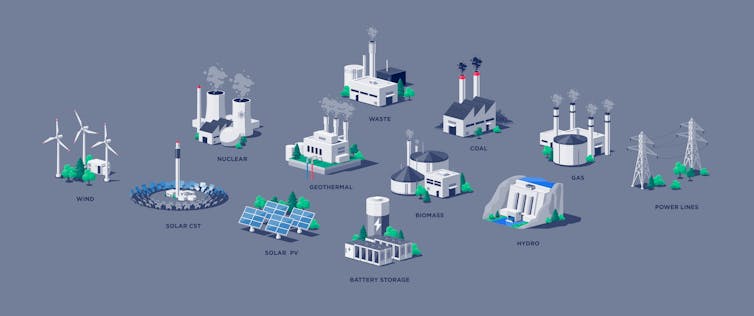CSIRO’s latest annual GenCost update, released last month, was billed as Australia’s “most comprehensive electricity generation cost report”.
GenCost has proven to be highly controversial. Opposition Leader Peter Dutton previously levelled robust criticism at the report, specifically the high costs attributed to building nuclear power in Australia, and called for a rerun of the numbers. In turn, CSIRO’s chief made a similarly robust defence of the report and of his agency.
This debate speaks to a key problem with GenCost and similar reports that strive to nail down numbers for the cost of new power sources.
The problem is, these numbers depend on many, many variables. We can’t simply say one type of power is cheaper than another.
Comparing costs of power from different plants is extremely difficult. petovargo/Shutterstock
Seeking impossible certainty
In 2018, Australia’s energy market operator (AEMO) asked CSIRO to help provide costings as it developed its Integrated System Plan, a blueprint for the development of the electricity system in Australia’s southern and eastern states.
This is where GenCost comes from. Every year, CSIRO experts work to compare the average cost of electricity from different sources, by reporting the capital (construction) and operating costs of electricity generation of different types of power sources.
It also estimates a measure of average costs, formally known as the “levelised cost of electricity”.
Trouble is, CSIRO is trying to do the impossible. We simply cannot know for sure how the economics of specific plants compare. There are many reasons for this.
1. Upfront cost
The cost of renewables is concentrated up front in construction; they cost very little to run. By contrast, the cost of nuclear, fossil fuel and biomass plants is spread out over their lifespan, because they have large fuel costs and cost much more to operate and maintain. Comparing these two groups requires many subjective assumptions on lifetime, fuel costs, closure costs and the operating regime. Different assumptions give radically different results.
2. Technical characteristics
Wind, solar and run-of-river hydro generators produce electricity at rates which vary with the weather, while those with stored fuels (nuclear, coal, biomass, hydro and gas) can produce electricity on demand. Weather-dependent generation is often cheaper than stored-fuel generation but to fairly compare it to stored-fuel generation it requires storage. How much storage you need is heavily contested. Power systems depending only on renewable electricity and storage will be prohibitively expensive with current technologies, according to our research. In South Australia, our modelling shows the first 5 GWh of storage displaces substantially more stored fuel power than the next 15 GWh, which displaces about as much as the next 180 GWh of storage.
3. New transmission
Some solar and wind farms might need new transmission lines to connect their power to the grid, while others can tap into existing transmission lines. Blanket calculations – such as those in GenCost of transmission costs associated with new wind and solar – are not meaningful.
4. Upstream infrastructure
A coal power plant needs a coal mine, a gas plant needs gas fields and pipelines. These costs are often (but not always) fully accounted for in the calculation of stored-fuel generator operating costs.
5. Local environment
Both weather-dependent and stored-fuel generators can damage the local environment and affect local communities through air, land and water pollution and loss of amenity. These are real economic costs, though sometimes called social costs, and impacts vary greatly from one generator to another.
6. Fossil fuels differ
Fossil-fuel generators are worsening global warming, but there are significant differences among different generators. CSIRO has not accounted for greenhouse gas emissions in its comparisons.
How do you properly compare different sources of power? posteriori/Shutterstock
7. Substitute or complement?
Generators, storage and transmission can be substitutes, meaning building one avoids building another (locating generators close to cities might avoid building transmission lines), while at other times they can complement (building renewables creates incentives to build batteries). A realistic comparison must account for this. Again, blanket generalisations are not possible – it has to be case by case.
8. Convention
Conventions on the allocation of costs greatly affect comparison. For example, the way transmission costs (or access rights) are allocated between new entrants and incumbents affects comparison of generators. Different approaches produce quite different costs.
9. Assumptions versus reality
There’s often a wide gap between how generators are assumed to operate, and how they actually operate. Once built, generators respond not just to the availability of wind, sun, coal, water, gas and so on, but also to the physical system and market prices. Most coal plants in the National Electricity Market no longer produce electricity consistently, due to being pushed out by renewable generators which cost almost nothing to operate. Similarly, wind farm operators respond to abundant solar by cutting generation during the middle of the day.
GenCost does not account for this. But it can be very significant. Our analysis suggests market prices and transmission could push average costs for solar power in Victoria’s Murray region 62% higher than the market operators is modelling.
Known unknowns
Of these nine factors, GenCost ignores the last five. While the report takes the other factors into account, different approaches for each of these would give very different answers.
Comparing the average costs of wind, solar, nuclear, hydro and coal power sounds like a simple thing to do. But the only plausible answer is: “it depends on many barely known and many unknown things”.
It would be constructive to seek to identify those things and their relationships to each other, rather than attempting to provide certainty.
Our energy market operator and chief scientific agency have got themselves into the position of providing supposedly definitive, objective answers to questions that do not lend themselves to definitive, objective answers.
In response to the claims made in this article, a CSIRO spokesperson said:
GenCost reports are updated annually to provide cost range estimates for new build electricity generation technologies using the best available data and modelling common in the industry.
Open to transparent public consultation and industry input, Gencost is policy- and technology-neutral and provides representative cost range estimates. Specific projects are not in scope for GenCost and investors must do their own deeper studies and analysis to determine all potential costs to a specific project.
What should we do?
In place of commissioning grand plans, our governments should instead broadly indicate their desired direction, consistent with the legislated economy-wide emission reduction targets.
If our government finds it politically unviable to price greenhouse gas pollution, it must provide financial support for clean generation expansion consistent with the legislated emission reduction policy and the governments’ broad direction.
Beyond that, policymakers, CSIRO and the market operator, AEMO, should get out of the way and leave it to the industry, customers and other interested parties to find agreement.
This is roughly how things worked before GenCost and the ISP. We can move forward by winding the clock back.



 Trump’s "Shock and Awe" Agenda: Executive Orders from Day One
Trump’s "Shock and Awe" Agenda: Executive Orders from Day One  China's Refining Industry Faces Major Shakeup Amid Challenges
China's Refining Industry Faces Major Shakeup Amid Challenges  UBS Projects Mixed Market Outlook for 2025 Amid Trump Policy Uncertainty
UBS Projects Mixed Market Outlook for 2025 Amid Trump Policy Uncertainty  Energy Sector Outlook 2025: AI's Role and Market Dynamics
Energy Sector Outlook 2025: AI's Role and Market Dynamics  Goldman Predicts 50% Odds of 10% U.S. Tariff on Copper by Q1 Close
Goldman Predicts 50% Odds of 10% U.S. Tariff on Copper by Q1 Close  U.S. Stocks vs. Bonds: Are Diverging Valuations Signaling a Shift?
U.S. Stocks vs. Bonds: Are Diverging Valuations Signaling a Shift?  2025 Market Outlook: Key January Events to Watch
2025 Market Outlook: Key January Events to Watch  Moody's Upgrades Argentina's Credit Rating Amid Economic Reforms
Moody's Upgrades Argentina's Credit Rating Amid Economic Reforms  Lithium Market Poised for Recovery Amid Supply Cuts and Rising Demand
Lithium Market Poised for Recovery Amid Supply Cuts and Rising Demand  Gold Prices Fall Amid Rate Jitters; Copper Steady as China Stimulus Eyed
Gold Prices Fall Amid Rate Jitters; Copper Steady as China Stimulus Eyed  Indonesia Surprises Markets with Interest Rate Cut Amid Currency Pressure
Indonesia Surprises Markets with Interest Rate Cut Amid Currency Pressure  Global Markets React to Strong U.S. Jobs Data and Rising Yields
Global Markets React to Strong U.S. Jobs Data and Rising Yields  Gold Prices Slide as Rate Cut Prospects Diminish; Copper Gains on China Stimulus Hopes
Gold Prices Slide as Rate Cut Prospects Diminish; Copper Gains on China Stimulus Hopes  Fed May Resume Rate Hikes: BofA Analysts Outline Key Scenarios
Fed May Resume Rate Hikes: BofA Analysts Outline Key Scenarios  UBS Predicts Potential Fed Rate Cut Amid Strong US Economic Data
UBS Predicts Potential Fed Rate Cut Amid Strong US Economic Data  Geopolitical Shocks That Could Reshape Financial Markets in 2025
Geopolitical Shocks That Could Reshape Financial Markets in 2025  China’s Growth Faces Structural Challenges Amid Doubts Over Data
China’s Growth Faces Structural Challenges Amid Doubts Over Data 


































